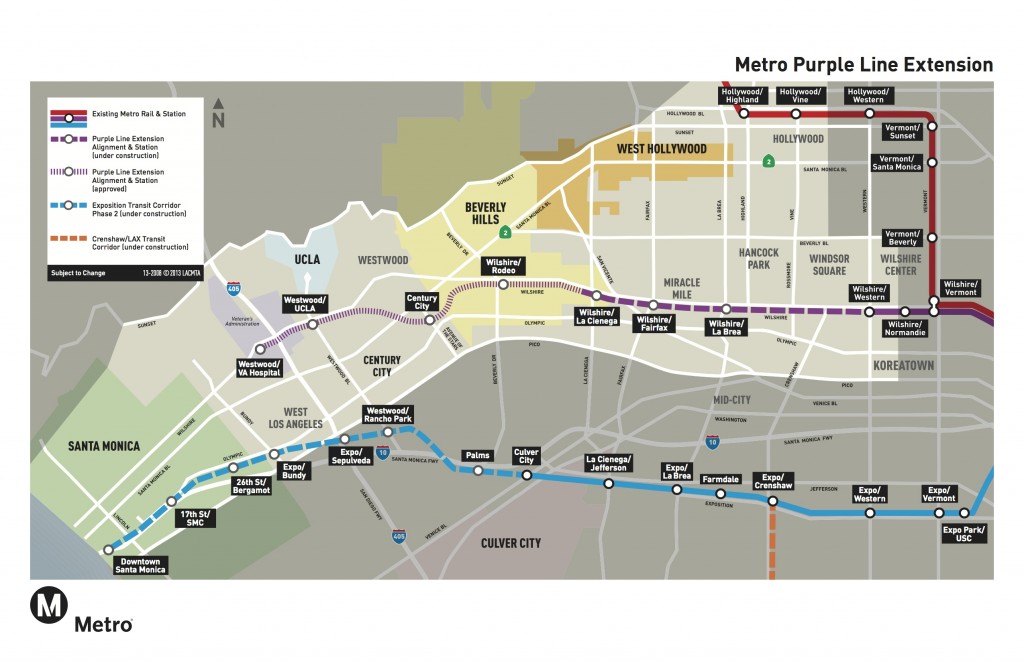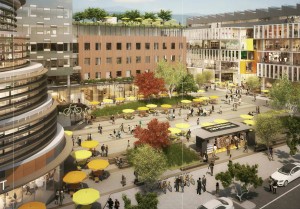 Time to fill in the dotted blue dots on the Expo Line map above to Santa Monica: as of today at noon, they’ll be solid blue as the route becomes operational.
Time to fill in the dotted blue dots on the Expo Line map above to Santa Monica: as of today at noon, they’ll be solid blue as the route becomes operational.
So what’s next? Here’s what I’ll be looking for in the months (and years) to come:
- Long travel times: will people be frustrated by the nearly hour end-to-end ride from downtown Santa Monica to downtown L.A.? Current time projections are 50 minutes, which is a long time for a ride that can take 15 minutes by car with no traffic. The LA Weekly and Los Angeles Times have done a good job of flagging this issue. There are no easy solutions, but at a minimum the City of L.A.’s transportation department should give the trains signal priority so they don’t stop at red lights downtown. Meanwhile, Metro should consider skipping under-performing stations, at least temporarily.
- Collisions: with the train running most at-grade (i.e. street level) and going through some funky intersections from the old railroad right-of-way, will the line experience a lot of accidents like the similarly situated Blue Line, one of the deadliest in the country? And what will the political response be? Easy solutions would be more crossing gates to block traffic, including for those driving in the wrong lane who try to get around single-lane crossing gates (it happens).
- The Expo bike lane: part of the rail extension includes a badly needed dedicated bike path. There’s a gap in the route though, apparently due to neighborhood opposition (what’s new). But the conditions are ripe to make this path even more successful, on a per traveler cost basis, than possibly the rail line next to it. The route is largely flat, the weather is great, and biking is super convenient. So this may be the unsung hero in the whole project.
-
Transit-oriented development along the route: the whole point of rail lines is really about economic development and land use, as Politico covered in an excellent profile on Denver’s burgeoning rail network. Right now, the route covers a lot of relatively low-density areas, and Santa Monica infamously shot down an office and housing project (see rendering) next to one of the new stations, resulting in a low-rise suburban office park to take its place. Will the cities along the route allow new development near the stations? If not, the line will be doomed to under-performance.
- Changing the politics of rail in Los Angeles: with rail now serving a highly visible, major job center in the region, will its existence solidify rail as a politically entrenched force? A bus activist in the Bay Area once told me that nobody would ever scale back BART in favor of buses now, because “BART is too precious.” Will the same thing happen to Metro Rail? As the system begins hauling more people and possibly taking a central role in economic development (subject to #4 above), it may lock in ongoing voter support for the foreseeable future. And not just in the westside. After all, with the eastern county Gold Lines operating, many of those residents will have a stake in accessing jobs in the western part of the county, too.
I’m sure other issues will arise as the system matures, and I’ll try to follow them on this blog. But for now, something to consider as many westside workers and residents of Los Angeles finally get their day to ride the rails.
One thought on “5 Things To Watch With The New Expo Line”
-
Pingback: Time To Consider Shutting Down Underperforming Expo Line Stations | Ethan Elkind
Leave a Reply
You must be logged in to post a comment.



